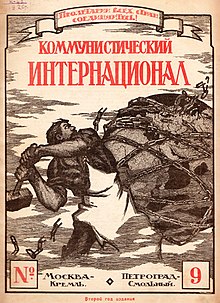Our website is made possible by displaying online advertisements to our visitors.
Please consider supporting us by disabling your ad blocker.
Communist International
Communist International | |
|---|---|
 | |
| Leader | Grigory Zinoviev (Chairman; 1919–1926) Nikolai Bukharin (de facto; 1926–1929) Dmitry Manuilsky (de facto; 1929–1935) Georgi Dimitrov (General Secretary; 1935–1943) |
| Founded | 2 March 1919 |
| Dissolved | 15 May 1943 |
| Preceded by | |
| Succeeded by | Cominform |
| Newspaper | Communist International |
| Youth wing | Young Communist International |
| Ideology |
|
| Political position | Far-left |
| Anthem | Kominternlied/Гимн Коминтерна |
| Part of a series on |
| Communism |
|---|
 |
|
|

| Part of a series on |
| Leninism |
|---|
 |
| Part of a series on |
| Marxism–Leninism |
|---|
 |
The Communist International (Comintern), also known as the Third International, was a political international which existed from 1919 to 1943 and advocated world communism. It was led and controlled by the Communist Party of the Soviet Union,[1][2][3] and maintained strict conditions of affiliation in order to exclude social democratic parties and more moderate or non-Marxist socialists. The international was intended as a replacement for the Second International, which had dissolved in 1916 during World War I.
The Comintern held seven World Congresses in Moscow between 1919 and 1935. During that period, it also conducted thirteen Enlarged Plenums of its governing Executive Committee, which had much the same function as the somewhat larger and more grandiose Congresses. It initially focused on supporting revolutionary activities in Europe, Germany in particular, and resolved at its Second Congress in 1920 to "struggle by all available means, including armed force, for the overthrow of the international bourgeoisie and the creation of an international soviet republic as a transition stage to the complete abolition of the state".[4] During the 1920s, the Comintern became a battleground for Soviet internal disputes, such as the struggle between Leon Trotsky and Joseph Stalin over the question of "socialism in one country" which ultimately saw Trotsky expelled in 1927. After this, the organization was largely under Stalin's direction.
From 1928, the Comintern adopted a "Third Period" policy of non-cooperation with social democrats against fascism, and denounced social democracy as "social fascism". On the Nazi Party's rise to power in Germany in 1933, this was reversed in favor of collaboration with socialists in "popular fronts" against fascism. The outbreak of World War II in 1939 saw the Comintern adopt a line of condemning both sides as imperialist, but after the German invasion of the Soviet Union in 1941 it began supporting the Allies, which the Soviets had joined, against the Axis. In 1943, Stalin dissolved the Comintern in order to avoid antagonizing his wartime allies, and the organization was succeeded in part by the Cominform in 1947.
- ^ Legvold, Robert (2007). Russian Foreign Policy in the Twenty-First Century and the Shadow of the Past. Columbia University Press. p. 408. ISBN 978-0-231-51217-6.
However, the USSR created an entirely new dimension of interwar European reality, one in which Russia devised rules of the game and set the agenda, namely, the Comintern.
- ^ Conquest, Robert (1990). The Great Terror: A Reassessment. Oxford University Press. p. 399. ISBN 978-0-19-507132-0.
It became instead a set of parties founded strictly on the Bolshevik model, and constitutionally subordinated to the Comintern - which always remained under effective Soviet control.
- ^ "Third International". Encyclopædia Britannica. Retrieved 3 December 2020.
Though its stated purpose was the promotion of world revolution, the Comintern functioned chiefly as an organ of Soviet control over the international communist movement.
- ^ Fisher, Harold Henry (1955). The Communist Revolution: An Outline of Strategy and Tactics. Stanford UP. p. 13.
Previous Page Next Page


